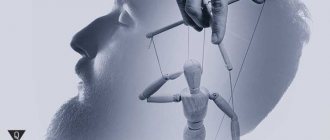Interest in psychology has increased significantly in recent years, and this is due to effective techniques of internal transformation. Self-hypnosis and active self-hypnosis help control your psycho-emotional state, manage yourself and your own life and not depend on the “mercy of fate.” My sister has been practicing self-hypnosis for 4 years, and this is a completely different person.
She gained confidence in her abilities, stopped having complexes and depression for any reason. Autosuggestion (self-hypnosis) was discovered at the beginning of the last century, but people began to become actively interested in self-hypnosis techniques not so long ago. Let's consider the issue in detail.
How to convince yourself of everything
Find out what awaits you today - Horoscope for today for all zodiac signs
Due to numerous requests from subscribers, we have prepared an accurate horoscope application for mobile phones. Forecasts will arrive for your zodiac sign every morning - it's impossible to miss! Download for free: Daily Horoscope 2020 (available on Android)
How does suggestion differ from ordinary mental activity? It lacks a critical component. That is, information is perceived as an axiom - without evidence. This presentation of information is perceived by the subconscious as true, so the necessary changes begin to occur in the depths of the human psyche. Self-hypnosis is a suggestion directed at oneself. By practicing self-hypnosis, you can change a lot within yourself and even construct a new personality.
Self-hypnosis can cause:
- the right sensations;
- necessary representations;
- necessary emotional states;
- changes in the autonomic system.
The basis of self-hypnosis is the constant repetition of verbal formulas. Correctly composed verbal formulas create positive impulses through repeated repetition. Formulas are repeated until they become a working tool of the subconscious for transforming something.
On a note! The subconscious is capable of transforming mental impulses into a physical equivalent, that is, materializing thoughts.
The rules of self-hypnosis are simple:
- all phrases are pronounced in the first person;
- all phrases must be affirmative;
- phrases should be short, but succinct in content;
- You cannot use the particle “not”; phrases must be formed without it;
- you cannot pronounce phrases automatically, without awareness;
- accompany the words with visualization (preferably).
What do self-hypnosis phrases look like? For example: “Every day I become more and more beautiful.” If you want to quit smoking, you should not repeat a phrase like “I don’t want to smoke.” It needs to be replaced with the phrase “I quit smoking.”
Psychologists have noticed that self-hypnosis works better when the body is relaxed. There is a direct relationship between physical and mental state: the more relaxed the body, the better the subconscious mind perceives information. Also, the effect of self-hypnosis depends on the strength of the desire to change something and on the degree of concentration of attention on the subject of self-hypnosis.
There are several methods of self-hypnosis:
- psychological mood;
- meditation;
- affirmations;
- mantras;
- prayers;
- visualization.
This is an incomplete list of psychotechniques to achieve the desired goal. Let's look at psychotechnics in more detail.
Self-hypnosis technique.
The Coue technique is based on verbal formulas that reflect desires, goals and aspirations. Essentially, these are the same affirmations. By compiling formulas for patients, Coue helped them get rid of not only psychological problems, but also some physical diseases. In addition, character correction took place, for example, stinginess was replaced by generosity, reserved people became sociable. The panacea was replacing negative thinking with positive thinking.
Take the test: optimist or pessimist
Correctly composed formula.
When composing formulas, you must adhere to the following rules:
- The thought form should be short and understandable.
- The wording should be simple and easy to remember.
- The formula is positive and does not contain the particle “not”.
- The formula is aimed at oneself, it uses the pronoun “I”.
Examples of successful formulas:
- I am happy in my relationship with my husband.
- I enjoy my work.
- I live in my own apartment.
- I travel twice a year.
- I'm healthy and feeling great.
When creating a formula, you don’t need to limit your imagination. If you want something that seems impossible, don’t be afraid to talk about it in affirmations. The subconscious mind doesn’t care what desire to tune in to, it’s just that it will take a little more time to complete complex tasks.
Time for pronunciation.
The best time to pronounce formulas is morning and evening. In the evening, when you go to bed, it is easiest to relax and tune your brain to a positive wave. At this time, the mind is ready to perceive new information, it will be easier for it to visualize it. When you wake up in the morning, you can take a few minutes to recite the formulas. But at this time it is better to tune in to a generally positive mood, for example, say to yourself: I am happy and full of vigor; I am ready for the new opportunities this day opens up; I'm confident.
But you shouldn’t limit yourself to just these periods. A great time for affirmations is traveling on a minibus or subway, or waiting in line at the dentist. The main thing is to tune in to the wave of positivity.
Rule 20 times.
Each formula must be repeated at least 20 times. If it is difficult for you to combine counting and pronunciation of the treasured phrase, you can finger a rosary with 20 beads, a cord with knots, and if you don’t have anything suitable at hand, you can simply press the pads of your fingers.
It is also important not only how many times the thought form is pronounced, but also how exactly:
- You need to speak on your own behalf.
- You need to do this out loud, maybe in a whisper, but so that your lips move and the person hears himself. Then the formula will be perceived by the brain as a task to be completed.
- Coue advises pronouncing words monotonously and mechanically. But many psychologists do not agree with him and recommend filling every phrase with emotion. This allows you to feel what exactly the fulfillment of a desire will give, what state it will plunge a person into. The brighter the emotion, the faster the subconscious will begin to look for ways to fulfill a dream.
Psychology and a little magic.
Each person must decide for himself what will help him fulfill his desire. Some people have a lucky dress that helps them pass an interview. For someone to have a successful day, they need to see 3 white poodles in the morning. Someone buys amulets. It's not stupid at all. This way, it’s easier for the brain to concentrate and believe that the wish can come true.
Affirmations
This is the simplest method of self-hypnosis, based on repeated repetition of the same phrase. You can repeat the verbal formula both out loud and silently: it does not play an important role.
In an affirmation, a person reports that he has already achieved some goal. For example: “I was healed of (name) disease.”
Thanks to the constant repetition of a positive formula, it will gradually begin to displace negative thoughts and attitudes. When not a single negative thought remains, the words of affirmation will come to life - materialize.
A type of affirmation is thanksgiving. This is an even more powerful psychotechnic, since the energy of gratitude is only slightly inferior to the energy of love. When uttering words of gratitude, strong emotions appear that directly affect the psyche and consciousness.
How do gratitude affirmations work? You need to thank the universe (God, the Absolute, etc.) for something, for example, for a new home. You may not have it yet, but the energy of sincere gratitude can materialize even such a seemingly complex object. Sincere faith, gratitude and self-hypnosis will do their job, and the house will materialize.
How to practice affirmations, when should you say them and how many times? Psychologists claim that the effectiveness of affirmations directly depends on the ability to make them the essence of your day. You can do whatever you want, but keep a verbal formula in your mind and repeat it.
So, affirmation is the simplest method of influencing the subconscious. Of course, they are not comparable to visualization, so frequent repetition is required to achieve success.
Self-hypnosis and mental self-regulation
Even in the pre-scientific era of the development of psychotherapy, one can find evidence of the use of autosuggestion in medical and healer practice. The history of the study of autosuggestion initially did not separate it from any suggestion at all. The Mansi school put self-hypnosis in first place and categorically asserted that there is no suggestion without self-hypnosis.
Russian natural science initially moved away from mysticism and was formed within the framework of natural scientific materialism already in the 18th century. A.N. Radishchev, for example, pointed out: “The tension of the mind distracts from the physicality and makes a person capable of overcoming work, illness, everything that the body is exhausted over.” The founder of Russian medicine, S.G. Zybelin, wrote back in 1877: “The disciplined mind subjugates the body into obedience, and no matter how much the body is inclined by nature or service to something, it will finally become weak and will be forced to give in to victory.” The victory of a disciplined mind over bodily illnesses is natural, and this fact argues for the need to use self-hypnosis methods to regulate bodily illnesses.
At the end of the last and at the beginning of the 20th century abroad, Bernheim and Levy, Coue and Baudouin, and here in Russia - V.A. Manassein, Ya.A. Botkin, V.M. Bekhterev became the founders of the scientific development of self-suggestion as a method psychotherapy. Coue’s books “Suggestion and Augosuggestion” (1925), and especially “The School of Self-Control through Conscious Self-Hypnosis” (1924), which showed the great clinical effectiveness of self-hypnosis, received enormous resonance.
The author formulates four starting points of his school:
- In the struggle between will and the power of imagination, the latter wins.
- The power of the imagination is directly proportional to the exertion of willpower applied.
- Will and imagination, acting simultaneously, dramatically enhance the effect of self-hypnosis.
- The power of imagination is subject to control and training. The considerations expressed by Coue, despite their inconsistency and not entirely scientific reliability, turned out to be useful for the development of specific methodological techniques for self-hypnosis. If these authors taught the “ABC” of self-hypnosis, then V.M. Bekhterev had already developed a specific technique for the so-called “dreaming” self-suggestion.
At the beginning of this century, the German neuropsychiatrist Johannes Schultz, having visited India, introduced into clinical practice the autogenic training method he developed, which subsequently underwent a number of modifications. E. Jacobson's method of progressive muscle relaxation makes it possible, for example, to quickly obtain the effect of muscle relaxation not so much on the basis of self-hypnosis, but due to muscle decontraction after tension.
Currently, autogenic training is a well-known therapeutic and preventive method of self-hypnosis, based on muscle relaxation, practiced in the East in ancient times as a means of relaxation and recuperation.
The increased cultural level of modern man, the growth of his self-awareness makes a significant amendment to a person’s attitude to medical and psychological actions, up to a “protest reaction” against the feeling of a “puppet” of the individual under hypnotic influences. This also affects the attitude towards the direct implementation of suggestion techniques. The growth of culture and self-awareness of the personality of our contemporaries dictates the need to increase the possibility of using various types of meaningful self-influence on a person’s personality and through it on the entire body, and therefore interest in autogenic training is increasing with a slight decrease in faith in the power of hypnosis with all the power of its therapeutic effects.
Self-regulation mechanism . The effectiveness of self-hypnosis is possible only under certain physiological conditions of muscle relaxation and a slight decrease in the level of wakefulness of the brain, in connection with which “report zones” are formed, which make it possible to actively use verbal formulations in conditions conducive to the implementation of second-signal self-influence. Due to the vasodilation that occurs during muscle relaxation and weakening of the wakefulness of the cerebral cortex, self-instruction receives, against the background of the inhibitory cortex, an irresistible influence on the entire cortex, on the vegetative subcortical formations, the RF (reticular formation) of the brain stem, on the underlying elements and on the entire organism as a whole. This explains the possibility, with the help of autogenic training with appropriate learning experience, to influence both a person’s mental state (for example, improve mood), and vegetative-vascular manifestations, blood pressure regulation, and the energy level of the body (brain RF).
Indications for AT. Professor V.E. Rozhnov (1978) gives a list of indications and contraindications for the use of AT. As can be seen from this list, the method of autogenic training has practically no contraindications and is widely used in healthy individuals for the prevention of neuropsychic overstrain and as a means of increasing mental and mental performance, and for therapeutic purposes, especially in functional disorders of the nervous system and internal organs. However, it is not recommended to use it for medicinal purposes without medical supervision. Individuals who are prone to a sharp decrease in blood pressure, who have suffered severe exacerbations of gastric and duodenal ulcers in the past six months, who have suffered a serious skull injury in the past, or who experience any unusual unpleasant sensations not described in the AT should not exercise on their own. . A relative contraindication is a skeptical attitude towards AT, the lack of clearly defined tasks and a negative attitude towards teaching this technique.
During the AT training process, blood pressure, vascular tone and skin temperature, breathing rhythm and heart rate are monitored. As a rule, AT students, through these data, are convinced that it can cause in a person not only a subjective feeling of warmth, but also affect the change in skin temperature, which increases when inspiring warmth on the skin of the back of the hand by several degrees (on average by 34 degrees Celsius).
AT options . Autogenic training is called psychotonic if it is aimed at changing the tone of the nervous system and the body as a whole. Self-hypnosis in the form of a psychotonic effect can manifest itself in some students in the form of neurovascular training, in which the effect is more pronounced when causing heat in the hand with vasodilation, which is the prevention of their spastic state. The neurovascular option helps to protect against these vegetative-vascular disorders, and when they have already arisen, helps to cure them. In some individuals, during autogenic training, the more pronounced effect is not the thermal effect, but the muscle-relaxing effect, which has an indirect effect as a means of relaxation, relieving muscle tension and general stiffness. This is a muscle relaxant version of AT. It is no coincidence that K.S. Stanislavsky recommended learning exercises to “relieve muscle tension” in order to achieve greater psychological freedom.
Finally, the actual psychoregulatory effect can be felt during autotraining in relieving anxiety, fears, irritability, and insomnia. A psychotonic effect is observed with self-hypnosis of tonic sensations of “pleasant chills,” coolness, springiness, etc., which somewhat raises and normalizes low blood pressure, increases performance and relieves fatigue (K.I. Mirovsky). For some people, with symptoms of incipient overwork, more passive options for autogenic training are not contraindicated - relaxation with voluntary muscle relaxation and achieving the effect of self-immersion, rest such as half-asleep, during which the body, while resting, is not deprived of autoinformation regarding its mental balance, good mood, vigor and others qualities that are sometimes lacking in an improving personality, for example, elements of a progressive worldview and ideological stability.
The beginning of any relaxation involves inducing in oneself the idea of relaxation and warmth in the muscles, most often in the right hand. Some authors (for example, A.V. Alekseev) recommend starting with a “mask” of relaxation on the face. With the help of imagination or the revival of “engrams” of traces of once previously felt relaxation and warmth, a person inspires these sensations in himself, achieving with each subsequent time an increasingly faster and clearer realization of what is being suggested.
The right hand is the organ of action, so it is with it that it is useful to begin self-hypnosis. In the process of evolution, it caused differentiation and high development of the crossed left frontal lobe of the brain, in which the speech centers are located. Therefore, turning to his right hand, the trainee “turns on” the mechanism of internal speech, preparing the body to perceive its own self-suggestions. Sensations of warming in the right hand or relaxation in it serve as an “indicator light” that the nervous system is “ready” to perceive the necessary information. Figuratively speaking, by first warming up the right hand, we are, as it were, warming up the engine of self-hypnosis. Then you should relax your left arm, both legs, and your whole body. You can move on to the facial muscles and self-regulation of the respiratory system and all internal organs, addressing, in particular, the suggestion to the cardiovascular and respiratory systems. By self-hypnosis you can achieve calm, painless and rhythmic heart function, relaxation of the heart muscle, improved blood supply, equalization of breathing, and improved functioning of the gastrointestinal tract. It is recommended to exercise two to three times a day for a few minutes every day. When working independently, after a month of training, it is usually possible to realize the basic beneficial sensations of warmth and relaxation. The best time for relaxation is either the afternoon hour, or the pre-sleep and pro-waking state, during which the brain is somewhat inhibited or has not yet fully entered into wakefulness. Both states create the necessary semi-inhibitory background for relaxation and self-hypnosis, freeing the mind from scrupulous and excessive criticism.
Exercises should not be accompanied by tension or a feeling of struggling with oneself. Formulas should not contain negation of anything. They should be done in a brief, positive-realistic manner. There is no need for formulas like: “I will not be irritated,” because the positive characteristic of the state is better realized: “I am completely calm.” When attention and rationality are weakening, it is useful to evoke a feeling of coolness in the forehead: “A fresh breeze blows across the skin of the forehead, my head is clear, I can concentrate without being distracted from the main thought and goal.” Group training is often more acceptable, because success appears for many, and it inspires those who initially have difficulty implementing self-hypnosis.
It is possible to distinguish several options for the implementation of self-hypnosis, and this depends to a certain extent on the type of personality: some initially do not experience warmth or relaxation in their right hand for a long time, but when they believe in the possibility of such an implementation of self-hypnosis, they do not give up their studies and train hard (“ there wasn’t a penny, but suddenly it was altyn”). With the second option, the first steps are easy, but in the middle there is some decline, and only with a strong-willed effort it is possible to obtain the effect of realizing self-influence in the end.
As for the stages of AT mastery themselves, then, on average for different personality types, the following three stages of AT can be taken “out of the bracket.”
Stage 1 - unstable modulation, when suggestion fails due to the fact that side streams of thoughts interfere, at the second stage - voluntary inclusion - it is possible to push them aside and at the third stage - directive motivation - self-hypnosis almost automatically turns into self-order, so that it is possible to achieve the transition of self-hypnosis into self-influence, which results in a significant self-regulatory effect.
You can carry out self-hypnosis with your eyes open, using the “ express method ”. Several pre-done breathing exercises can help relieve tension. Even simple breathing exercises (through each nostril alternately) are a calming factor before important speeches and meetings.
Higher levels of autogenic training are also possible, more associated with the presentation or imagination of some stories.
Training volitional self-control can be very difficult for a single performer. Joint training with a role-playing simulation of a “psychodramatic situation”, “role-playing psycho-gymnastics”, where a special scenario is used with the goal of responding to a conflict, resolving it, adapting to difficulties, and normalizing relationships are useful. It is possible in a role-playing situation to actively express anger in order to get rid of it in a real situation. Sometimes, on the contrary, introversion of behavior is trained in order to get rid of excessive wastefulness in communicating with others, scatteredness in one’s mental activity.
It is useful to carry out differentiated autogenic training for progressive muscle relaxation of those muscles whose tension is not required at the moment. So, when walking, the muscles of the legs tense, which means you need to relax your free limbs - arms, face; When having a sedentary conversation, relax the muscles of your arms and legs. Relaxation is also possible by contrast through tension. Squeezing your wrist or hand, you should then “release” the muscles and feel the beauty of relaxation that comes after prolonged tension. Strain your legs all the way to the floor, and then relax, feeling the joy of getting rid of stiffness. Such active relaxation is applicable in any “hiking” conditions.
Psychoregulatory training is at the same time the highest discipline of the will. Its version is called emotional-volitional training (A.T. Filatov). The outstanding Russian teacher K-D. Ushinsky correctly pointed out: “Our will, like our muscles, grows stronger only from gradually increasing activity; with excessive demands you can strain both the will and the muscles and stop their development, but without giving them exercise, you will certainly have and weak muscles, and weak will,” (op.t.b, p.249).
You can even learn to stay focused throughout the entire working day. if the work seems monotonous and uninteresting, you can prevent your impulsive action, even in a tired state, if you practice emotional-volitional training exercises. Good “advisers” here are the life situations themselves, developing the habit of self-control, the habit of systematically doing the work that you wouldn’t want to do right now. One of the techniques for training self-control is to “throw” thoughts ahead of the action. It is also necessary to practice not only in performing exercises for the transformation of the desired image (“theater of experience” according to K.S. Stanislavsky), but also exercises “for alienation” (techniques of the “theater of presentation” by B. Brecht) about developing techniques of disidentification, “anti-transference” with negative characters in life and art.
Below are more specific options for mental self-regulation through mental training, i.e. using influence on the mental sphere, psychophysical or breathing exercises, etc.
Visualization
Another psychotechnic for influencing the subconscious. Visualization is like a feature film inside your mind. A person sees vivid pictures of any event, smells and tastes, feels emotions. What should you present? For example, you need your own home - imagine it. You can first make a drawing of the house or find a picture and print it on a printer.
What do we have to do? Just imagine how you are already living in this house, that you are the rightful owner (mistress) of a two-room apartment/three-room apartment/cottage/dacha. You can imagine before bed, when the body is relaxed and preparing for sleep. You need to get used to this situation that you imagine, live in it constantly.
What is the effectiveness of visualization based on? The brain perceives imaginary pictures in the same way as real ones. Some time will pass, and all your ideas will come to life and be embodied in matter.
You just need to imagine not from the side or from above, but from inside the situation. For example, you are sitting behind the wheel of a car and looking at the road. If you imagine that the car is somewhere near you, then everything will come true - next to you. It's the same with the house. You should vividly imagine inserting the keys into the keyhole and entering your home. You can first visualize empty walls, and then gradually furnish the house with furniture.
How long does it take to visualize? There is no clear time frame for this psychotechnics. It is more important to completely relax your body before visualization than to track the duration of the internal movie session.
Self-hypnosis methods. Psychotechnicians
Suggestion is the presentation of information, perceived without critical evaluation and influencing the course of neuropsychic processes. Self-hypnosis is a process of suggestion addressed to oneself. Through self-suggestion, sensations, ideas, emotional states and volitional impulses can be evoked, as well as influence the autonomic functions of the body.
The essence of self-hypnosis methods is the formation of positive impulses through the constant repetition of specially selected phrases until they turn into a working tool of your subconscious and it begins to act according to this impulse of thought, transforming it into a physical equivalent. Repeating settings for the subconscious is the basis of self-hypnosis.
Words and phrases of self-hypnosis must be mentally pronounced in the first person in an imperative tone and always in an affirmative form. The negative particle “not” is excluded from verbal formulas. You cannot say “I don’t smoke.” You need to say “I quit smoking” or “I stopped smoking.” You should also not pronounce long monologues. Phrases should be short, they should be pronounced slowly with full concentration on the subject of suggestion. While pronouncing each self-hypnosis phrase, it is advisable to vividly imagine what is being suggested.
Self-hypnosis methods work most effectively when active thoughts in the form of target formulas (thoughts that carry a clear, meaningful message to the subconscious) occur against the background of a state of relaxation in the body. The more relaxed the body is, the more pliable the subconscious becomes for target settings. The power of self-hypnosis is directly dependent on the degree of desire to achieve a specific goal, on the degree of concentration of attention on the settings for the subconscious.
There are quite a large number of methods of self-hypnosis - these are affirmations, psychological attitudes, various meditative techniques, visualization, mantras, prayers and many other psychotechniques.
AFFIRMATIONS – THE SIMPLE METHOD OF SELF-HYPOPTIATION
Affirmations are a method of self-hypnosis where you repeat formulas out loud or silently. The point of this psychotechnic is that you construct a sentence in which you say that you have achieved a certain goal. For example, “I have good health”, “I am confident in myself”, “I have a good job”, “I am married to my loved one”. What exactly to repeat depends on your goal. Thanks to affirmations, positive thoughts will begin to replace negative ones and gradually completely supplant them. And then everything that you repeat will come true in your life.
Gratitude is a type of affirmation, but a much more powerful psychotechnic. Gratitude is the second most powerful emotion after love. Because when we give thanks, strong emotions arise at the same time, and this has a powerful effect on the psyche and consciousness. You need to be grateful for everything you have and say: “Thank you, Lord, for good health,” “Thank you for my new home,” even if you don’t have one. Thank you sincerely, from the bottom of your heart, as if you already have this home. And over time, self-hypnosis will do its job and you will have something repeatable.
The most common state of a person, in which he usually lives every day, is suitable for this psychotechnics. The effectiveness of affirmations will depend on how much the practitioner can make the spoken words the essence, the content of his entire day. That is, you can do whatever you want: work, relax, play sports, sunbathe, as long as the necessary affirmation continues to live on the surface of your memory.
Affirmations are the simplest method of self-hypnosis and, accordingly, this is the easiest way to influence the subconscious; they are less powerful than visualization and need to be repeated more often. But they are also effective and easy to use.
VISUALIZATION
Visualization is the mental representation and experience of imaginary events. The essence of this psychotechnics is to simply imagine the desired situation and live in it. Visualization is so effective because our minds do not differentiate real events from imagined ones. When you imagine something, the mind believes that it is actually happening. It is very important to perceive everything with your own eyes. Not from above, not from the side, but with your own eyes. If you imagine a car, you must imagine that you are driving that car and you are looking at the road. Your goal is to buy a house. Imagine how you insert your keys into the keyhole and open the door for the first time, how you enter the house, how you look around it. Your visualization should be only positive and carry an exclusively positive charge.
You need to visualize in a comfortable, calm environment, so choose a time and place when no one will distract you, and take a comfortable position. Relax. Imagine that your muscles, starting from your toes and ending with your head, alternately relax. The tension leaves you. The mental image that is embedded in the subconscious must be very clear and vivid - then the subconscious will be able to give commands to the corresponding organs and tissues.
The duration of this psychotechnic is not particularly important. The main criterion is your pleasure. Visualize it for as long as you like it. This can last as long as an hour or five minutes. The main thing is that the process should be enjoyable. The more often you imagine the desired image, the sooner the renewal process will begin. And the result may simply amaze you!
Self-hypnosis method E. KUE
When performing this psychotechnics, a person takes a comfortable position, sitting or lying down, closes his eyes, relaxes and in a whisper, without any tension, monotonously pronounces the same self-hypnosis formula several times (at least 20). The formula should be simple, consisting of a few words, a maximum of 3-4 phrases and always have a positive content. For example, “I am healthy.” In no case should it contain the particle “not”, since the denial of any action or phenomenon is not recognized by the subconscious and can be mistaken for the opposite statement. A session of this self-hypnosis method lasts 3-4 minutes and is repeated 2-3 times a day for 6-8 weeks. E. Coue recommended using drowsy states for psychotechnical sessions in the morning when waking up or in the evening when falling asleep.
Autogenic training
Autogenic training is a method of self-hypnosis in a state of relaxation (lowest level) or hypnotic trance (highest level). The creator of the autogenic training method is Johannes Heinrich Schultz, and he also owns the term “autogenic training.” This psychotechnics is based on the findings of the ancient Indian system of yoga, the experience of studying the sensations of people immersed in hypnosis, the practice of using the method of self-hypnosis by E. Coue and others.
By practicing this method of self-hypnosis, it is necessary to achieve relaxation, which occurs on the verge of reality and sleep. It is recommended to lie or sit in the “coachman” position. Having achieved relaxation, it is necessary to: - activate memories associated with pleasant sensations experienced in the past, - cause, if necessary, not only calm, but also an increase in psycho-emotional tone, - accompany self-hypnosis formulas with figurative ideas.
The effectiveness of using this psychotechnics will depend on the degree of concentration, so other matters are excluded. The self-hypnosis method requires daily practice, at least twice a day. Skipping at least one has an extremely bad effect on achieving the effect.
A type of autogenic training is imago training. The author of this method of self-hypnosis is Valery Avdeev. He claims that with the help of imago training, every person without any training is able to step far (under the direct supervision of an imago training specialist) beyond the limits of his usual capabilities and reveal his creative abilities.
Meditation
Meditation is intense, penetrating contemplation, immersion of consciousness into the essence of an object, an idea, which is achieved by focusing on one thing and eliminating from consciousness all interfering factors, both external and internal.
A necessary condition for meditation is the cessation of internal dialogue, the conversation that we constantly have with ourselves. Stopping it is not difficult at all. To do this, it is usually enough to focus on something in yourself. For example, on both hands at once.
Meditation is a psychotechnic that allows you to repeatedly increase your physical, intellectual and mental capabilities, reaction speed and much, much more; in principle, it is very simple. It can be divided into four parts, four components: – definition of installation; – entering a state of emptiness and a real feeling of a given attitude within oneself; – exit from a state of emptiness to a normal state with an attitude already embedded in the subconscious; – if it is necessary to carry out the installation, spontaneous entry into a state of thoughtlessness and its implementation.
Installations should be extremely concise, succinct and at the same time bright.
Self-hypnosis
Self-hypnosis is one of the most powerful psychotechniques. The first step is to relax. Then you need to calm down and enter a state of peace. Then say the phrase “I am deeply asleep...”. Next, you should mentally count from five to zero, imagining how you are breaking away further and further from the familiar world, plunging deeper into the darkness of hypnotic oblivion. After counting “zero,” say the key phrase “I am deeply asleep...” again and mentally look around. You are inside your subconscious. Now it’s time to pronounce a formula that will help you achieve this state faster in the future. It goes like this: “Every time I say the words “I am deeply asleep...”, I enter a state of self-programming faster and faster.”
This formula must be repeated several times at each of the first lessons and only after that the self-hypnosis formulas must be spoken.
Recapping
Recapping is an effective psychotechnique that makes it possible to re-experience a past situation in a concentrated way, but to experience it in a new way. Re-experiencing is the recognition of new possibilities in an old situation, not for then, but for new opportunities now. We are talking about situations that are still significant today. That’s the only reason it makes sense to experience them, that’s the only reason they can be experienced. To actually experience a situation again means to see new possibilities in it.
The main provisions of this psychotechnics are as follows: 1. The situation must be re-experienced (real experience), and not just restored in memory. 2. The situation must be experienced in its significant components, which alone make it a given existential situation. The reality of significant components of a situation is determined by the fact that they can be deployed, there is something in them that can be re-examined, rethought, etc. 3. You need to restore and reproduce in the situation what happened for you personally. The situation is always your personal, individual, existential situation. And what was around there was a gradually dissolving, disappearing background.
Attitudes are an effective method of self-hypnosis
For this method of self-hypnosis, an active state is important, when a person’s consciousness reaches its maximum degree of concentration. Therefore, while performing the mood, it is necessary to behave as actively as possible: it is best to walk or move vigorously, but not lie down. However, it is not recommended to be distracted by any other activity.
Moods are words addressed by a person to himself, an attempt to awaken the forces dormant in the depths of each of us. The fact that the words are spoken by the person himself will not weaken their influence. On the contrary, a conscious and clearly expressed word that comes from within, in which the speaker himself believes, will have a much more pronounced effect than what was heard from another.
Psychotechnics – balloon
Visualize a deflated balloon above your head. Take a deep breath and as you exhale, imagine how all your problems and anxieties, fears, worries and various troubles fill this ball. You are completely freed from these worries by filling the balloon with them. Then, taking another deep breath, as you exhale, visualize the balloon floating up and disappearing, taking with it all your worries and problems that you put into it. This is an excellent psychotechnique that is best done before bed, especially if problems are preventing you from sleeping.
SHICHKO self-hypnosis method
This psychotechnics was developed by Gennady Andreevich Shichko. He experimentally established that the word that a person writes with his hand before going to bed has a hundred times greater impact on the subconscious than the word seen, spoken or heard.
Psychotechnique is performed as follows. Before going to bed, write the suggestion formula on a piece of paper with a pen (you can write it several times). You read it several times. Then go to bed and, reciting the suggestion formula, fall asleep.
Coue's self-hypnosis method
The technique of self-hypnosis according to the Coue method is based on repeating the same phrase (or 3 - 4 phrases) in a drowsy state or immediately before falling asleep. At these moments, the human brain works at a special frequency, which allows information to penetrate the subconscious without obstacles.
For example, immediately after waking up, before opening your eyes, you need to repeat to yourself at least 20 times the key phrase “I am healthy” (or another). You will also need to find time to repeat affirmations 2 times during the day. You need to relax - lie down or close your eyes while sitting - and say the key phrase out loud or to yourself at least 20 times. It usually takes 2 - 2.5 months to materialize the plan.
What are the methods of self-hypnosis?
Let's take a closer look at several effective methods of self-hypnosis.
Visualization
Visualization is the mental experience and representation of certain imaginary events. Self-hypnosis is what helps us visualize. Why is the method so effective? It's simple: our brain does not distinguish real events from invented, imaginary ones.
How does it work? You begin to create mental pictures in your imagination - the brain believes that this is reality. Purpose of visualization: representation of desired events. Simply put, with the power of thought you transport yourself to the desired situation and stay in it. It is important to imagine everything as if from the inside, and not from the outside. Example: you imagine the car you want not somewhere in the distance - you imagine yourself sitting behind its wheel, looking at the street through its window, and so on. The car does not drive on its own, it is not driven by someone - it is you who drive it and ride in it. Visualize everything down to the smallest detail.
Affirmations
Affirmations are simple statements that you say out loud or mentally. What is their meaning? You simply construct a sentence in which you managed to achieve your goal. Example: “I make good money, I have enough money for everything”, “I bought a new apartment”, “Everyone loves me” and others. Start from your own goal.
How do affirmations work? The principle of substitution applies. The mind can only process one thought at a time. Create a sequence of moments with the same (desired) thought. What will happen in the end? Let's look at a simple example: in front of you is a glass of cloudy water. You bring it under the tap and, without pouring out the previous water, pour new water into it. Gradually, clean water will completely replace dirty water. The cloudy liquid is displaced and the clean liquid replaces it. Gradually, only clean water remains in the container. That is, no matter how the situation around you develops, surround yourself with positive attitudes that will eliminate the negative over time.
Only clean water will remain in the glass. It's the same with the mind. Whatever situation you are in now, start affirming positive thoughts to yourself. Over time, the positive will crowd out the negative.
Gratitude
The method can be called a type of affirmation, but it works even more noticeably. Why is this happening. It is believed that gratitude is one of the strongest emotions. By using affirmations, you intentionally evoke emotions, and with gratitude, they materialize on their own.
Let's compare two affirmations
:
- I bought a lot of new and beautiful things.
- Thank you for the new beautiful things.
The second one sounds more realistic. You may argue that this is self-deception, but there is no problem here, because we constantly engage in self-deception, which has a more destructive effect on us. Example: “They treat me badly, but I deserve it,” “I don’t deserve such a guy,” and so on. Why is such self-deception, with a negative connotation, allowed, but positive deception is not?
Autogenic training according to Schultz
The essence of this psychotechnics is active self-hypnosis and self-hypnosis in a state of relaxation or hypnotic trance. Schultz bases his technique on the ancient techniques of yoga, the sensations of people who have been in a deep trance and other similar methods.
For self-hypnosis, it is necessary to achieve a state similar to the state between reality and sleep. The recommended pose for relaxation is “coachman”. To achieve the necessary relaxation of the body, you need to remember something pleasant from the past. During self-hypnosis, you should be able to combine physical relaxation with psycho-emotional activity and be able to accompany verbal formulas with figurative representations.
To practice autogenic training, you need to completely abandon everyday worries and direct your attention to the subject of concentration. You need to train every day at least once; skipping even a one-day workout will negatively affect the result.
Meditation
Meditation is the concentration of thought on one object and the exclusion of all other thoughts and experiences. An important part of any meditation is stopping internal dialogue. Inside himself, a person scrolls through different thoughts, remembers conversations with other people: his mind is constantly busy with mental activity, which is called internal dialogue.
What can you do to clear your thoughts of internal dialogue? There is a very simple technique for this: you need to look at both your hands at the same time, and carefully. The mind will immediately stop conducting internal dialogue, as it will be busy contemplating two objects at the same time. Another method to stop the flow of unnecessary thoughts: focus on your breathing process, carefully record each inhalation/exhalation and listen to the sound of breathing. After a couple of minutes, your thoughts will be completely cleared of the vain dialogue.
The stages of meditation are as follows:
- determination of the object of meditation (installation);
- entering a state of emptiness;
- feeling within oneself of a given attitude and contemplating it;
- exit from a state of emptiness with an attitude embedded in the subconscious.
For meditation to be effective, the instructions must be short and succinct. It is important to feel them inside yourself, your inner world. How long will this take? Everyone has their own deadlines for implementation. During meditation, you need to be aware of the creation of another reality, as if in an “empty place” or in emptiness. The meditation can be repeated as needed.
Self-hypnosis
Self-hypnosis or self-hypnosis is the process of unconsciously or consciously influencing the subconscious with the help of feelings and thoughts. Further, when I talk about self-hypnosis, I will mean conscious suggestion. We engage in unconscious or unconscious suggestion very often, and it is mostly negative. However, conscious self-hypnosis gives positive results and plays a big role in a person’s life.
Our whole life can be thought of as a mirror that reflects all our beliefs and beliefs. And most of these beliefs and beliefs were formed by other people, not us and without our consent. For example, in childhood, when you were very small, you were often told that you were a complete loser or that you could not become a rich person because your friends and parents were poor, your subconscious, with the help of repeated repetitions, believed in this nonsense.
The fact is that your subconscious cannot distinguish whether this thought is good or bad, negative or positive. It only realizes what is given to it. And therefore, as an adult, in order to achieve wealth and success in life, you will need to consciously instill in your subconscious the opposite thought that you are a rich and successful person. As an adult, you will still be told that you cannot achieve success. Therefore, you yourself must “feed” your subconscious with the best and constructive thoughts. No one will do this for you.
This process is called conscious (conscious) self-hypnosis. Only you choose who and what you want to be, what achievements you want to achieve in life. And every day, day after day, you begin to hammer your ideas into your subconscious. This process is not easy, but it is quite simple. The main difficulty here is consistency (repetition). You must constantly “feed” your subconscious with the best and constructive ideas, or then it will again be replenished with negativity.
The main problem is that society is mostly mediocre. According to Pareto's law, it is divided in a ratio of approximately 80/20, that is, 80% are mediocre and only 20% are successful people. If we do not track the information that our subconscious perceives, then we have only one chance in five of becoming a successful and rich person. The fact is that there are more mediocre people, and we must consciously close our eyes to this so as not to see it. Self-hypnosis promotes a high level of concentration on success, on the best that surrounds our life at the moment, and then all this best will multiply.
The world can be compared to a mirror that ideally reflects your own world, which contains you inside. In other words, everything that is and happens around you is, first of all, an ideal reflection of your inner, rather than external, world.
Self-hypnosis helps build peace within us, which, of course, changes the outside world. But definitely not the other way around. The outer world is just a mirror of the inner world. The mirror only states a fact. Self-hypnosis can change the meaning, which will unconditionally affect the external reflection. What does a person usually do who does not know what self-hypnosis is and how to use it? Suppose an unpleasant event happened to him, in his opinion. He became very upset and began to assert: “What a terrible world this is, everything is so complicated, there is no money, etc.” These thoughts are very quickly recorded by the subconscious, since it believes in them 100%. And his subconscious immediately realizes his thoughts. And as a result, the result: it gets worse and worse.
What does a person do when he uses self-hypnosis:
- Makes a choice of what he wants to achieve and what he wants to have.
- Begins to use self-hypnosis daily to achieve his goals.
- Suppose, in his opinion, a bad event occurred.
- He says to himself: “The Universe knows better than me how best to achieve my goal, since my subconscious mind works specifically to achieve the goal.”
Self-hypnosis
Psychologists agree that self-hypnosis is the most powerful psychotechnic of all. First you need to completely relax physically and psychologically. You need to achieve a state of peace, and then say to yourself, “I am deeply asleep.”
After this, you should slowly count from five to zero and plunge into a state of hypnotic oblivion. After saying the word “zero,” you need to say to yourself again: “I’m sleeping deeply.” You have reached the depths of your own subconscious. Now we need to anchor this state for future self-hypnosis practices. Tell:
“When I say the phrase “I am in deep sleep,” I enter a state of self-programming.”
After this, you need to repeat the self-programming formula several times, for example, “I am completely healed and healthy.” Programming should only be in a positive way and without the particle “not”.
Thought Release Technique
How to quickly clear your thoughts of negative memories? For this there is a simple and effective psychotechnique “Balloon”. Imagine a deflated balloon above your head. Take a breath, and as you exhale, imagine how all the black negative thoughts come out of your head like a dark cloud into a ball. The balloon is inflated not by air, but by your negative thoughts.
Do this until you are free of the burden of negative memories and worries. Then take a deep breath and exhale and imagine how a round ball, along with your thoughts, comes off and flies into the sky. This psychotechnics always helps, especially if anxious thoughts prevent you from falling asleep at night.










